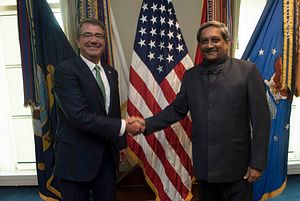Indian Defense Minister Manohar Parrikar met his U.S. counterpart, Secretary of Defense Ashton Carter, on Monday in Washington, D.C. The visit is Parrikar’s second to the United States as India’s defense minister and resulted in the conclusion of a long-anticipated bilateral deal on military logistics exchange, known as the Logistics Exchange Memorandum of Agreement (LEMOA), that was first mooted in the early 2000s. Parrikar and Carter additionally addressed the gamut of defense and security issues on the U.S.-India agenda, including defense technology collaboration, expanding military-to-military exchanges, and the U.S. designation of India as a “Major Defense Partner” (MDP) earlier this year.
The latter, in particular, received special attention from Parrikar and Carter during their joint press conference on Monday. As I discussed in June after Indian Prime Minister Narendra Modi’s visit to the United States, the “Major Defense Partner” designation for India was effectively a bespoke status, conferring upon India something like the status of a major non-NATO ally without calling it that. Critically, Modi’s statement with U.S. President Barack Obama noted that Washington would endeavor to “facilitating technology sharing with India to a level commensurate with that of its closest allies and partners.”
Carter and Parrikar took the opportunity on Monday to clarify that the MDP designation would “facilitate innovative and advanced opportunities in defense technology and trade cooperation.” Carter, as deputy secretary of defense from 2011 to 2013, spearheaded the Defense Technology and Trade Initiative with India, which opened the door on unprecedented technology cooperation between New Delhi and Washington. Talks are ongoing at the working group level on advanced aircraft carrier technology transfer from the United States to India, in addition to a range of other projects.
Both Carter and Parrikar further welcomed the signing of LEMOA. Carter, ostensibly aware of the debate within India, where opposition has sprung up against LEMOA amid concerns that it would erode Indian autonomy, remarked that it is not anything like a basing agreement. He described it as a “substantial enabler” of cooperation, emphasizing that all interactions under the pact are at an at-will basis.
As I’ve explained before, LEMOA (or the LSA as it used to be known) helps grease the wheels on the bureaucracy underlying defense collaboration, including reimbursements for military logistics sharing. India and the United States already share logistics on a case-by-case basis; LEMOA simply makes this easier. Parrikar and Carter provided few specifics on two other so-called “foundational” agreements that complement LEMOA—namely the Communication and Information Security Memorandum of Agreement (CISMOA) and the Basic Exchange and Cooperation Agreement (BECA).
The last year has seen a series of major advancements in the U.S.-India security relationship, which is increasingly becoming central to Washington’s vision of sustaining a “principled security network” in the Asia-Pacific. The two countries updated their ten-year defense cooperation framework last fall, followed by the June designation of India as a MDP, and now have concluded LEMOA. For regional states looking at this bilateral, it’s hard not to perceive a great deal of upward momentum.
With LEMOA behind them, the United States and India still have a lot to look forward to. The other two foundational agreements aside, New Delhi will no doubt be looking for clarity on where defense technology cooperation will go with its newfound MDP status. Murmurs of India flying domestically assembled U.S. F-16s and even F/A-18s have reemerged in recent months as well, suggesting a possible way forward for Modi’s “Make in India” initiative after Delhi decided to go with 36 French Rafale multi-role fighters in fly-away condition in a government-to-government deal last year.
What’s next for the United States and India? Well, it’s quite likely that Modi and Obama will meet on the sidelines of the upcoming G20 meeting in Hangzhou, China, exchanging words on defense and security matters. Though there likely won’t be any major deliverables announced on the sidelines of the international summit, the two will be keen to underline the positive momentum in U.S.-India ties.

































